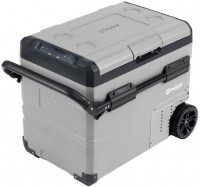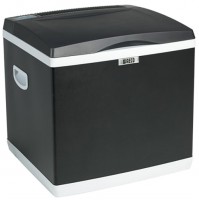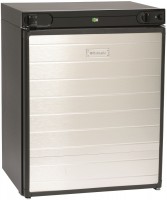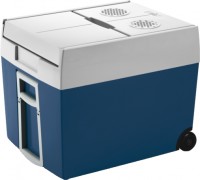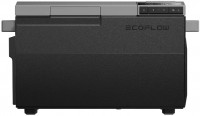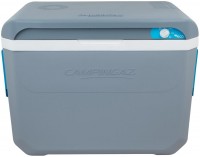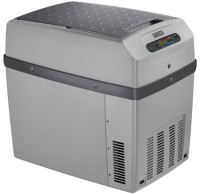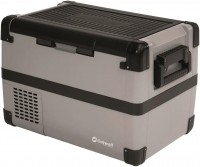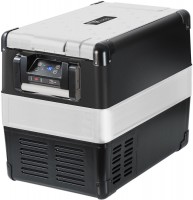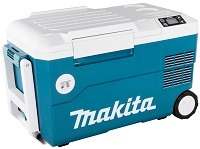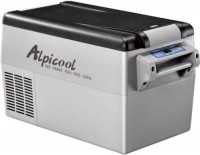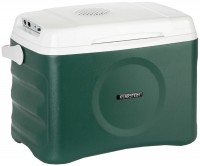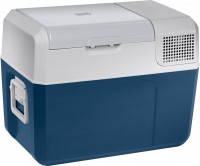Car Coolers & Fridges Dometic Waeco
All models Advanced filters → |
You might be interested in
Articles, reviews, useful tips
All materials
Cold accumulators — types and recommendations for use
Let's determine which types of cold accumulators are appropriate for different purposes

How to choose a car cooler
Having chilled food and drinks during the trip is an additional element of comfort for both the driver and passengers

What to give to a motorist?
10 practical gift ideas for drivers
Car Coolers & Fridges: specifications, types
Type
— Refrigerator container. Thermally insulated containers designed for use in cars and as close as possible to ordinary kitchen refrigerators both in functionality and appearance. They look like boxes, most often plastic, can have a rather large volume (40 liters or more), are designed primarily for stationary installation in a car and are usually quite inconvenient to carry (although most models can be easily carried in hands over short distances). Equipped with temperature maintenance systems (up to compressors, see "Functions"), they require external power supply.
— Cooler bag. Like the containers described above, this type belongs to car accessories, requires external power, is able to provide cooling similar to classic refrigerators, and can also have other modes of operation (see below). Externally, in accordance with the name, such models resemble ordinary bags, often have fabric upholstery, external pockets, and almost always carry handles. They are easy to transport in your hands, which can be useful for loading: it is often more convenient to load the refrigerator in the kitchen and transfer it to the car than to carry the products separately to the car. This design of the refrigerator is also especially convenient for outdoor trips, picnics, etc. On the other hand, bags usually have a small volume (not exceeding 40 liters).
— Embedded. As the name implies, this variety is desig...ned for permanent installation in vehicles. Its main difference from the containers-refrigerators described above is its poor suitability for carrying from place to place, in addition, such devices can have quite large volumes. Due to their large size, most built-in refrigerators are not well suited for passenger cars, where there is usually little space — but they can be very useful for buses, tractors, motorhomes, and even boats and yachts. Some of these models are originally made for a specific brand of car.
— Refrigerator-armrest. A specific type of refrigerator-containers (see the relevant paragraph). The main difference of this variety from the "ordinary" containers is just the possibility of installation as an armrest. At the same time, installation methods can be different: some models are placed in the centre of the rear seat and are fixed with a seat belt, others can also be installed between the front seats. The main advantage of such units can be called the fact that they create a minimum of discomfort, and often vice versa — they provide additional convenience, playing the role of the actual armrest. In addition, coasters and other additional devices can be provided on the case. However, before buying, you should make sure that the selected model is suitable for your car in shape and dimensions. Also note that the volume of refrigerators of this type is relatively small — usually less than 25 liters.
— Cooler bag. Like the containers described above, this type belongs to car accessories, requires external power, is able to provide cooling similar to classic refrigerators, and can also have other modes of operation (see below). Externally, in accordance with the name, such models resemble ordinary bags, often have fabric upholstery, external pockets, and almost always carry handles. They are easy to transport in your hands, which can be useful for loading: it is often more convenient to load the refrigerator in the kitchen and transfer it to the car than to carry the products separately to the car. This design of the refrigerator is also especially convenient for outdoor trips, picnics, etc. On the other hand, bags usually have a small volume (not exceeding 40 liters).
— Embedded. As the name implies, this variety is desig...ned for permanent installation in vehicles. Its main difference from the containers-refrigerators described above is its poor suitability for carrying from place to place, in addition, such devices can have quite large volumes. Due to their large size, most built-in refrigerators are not well suited for passenger cars, where there is usually little space — but they can be very useful for buses, tractors, motorhomes, and even boats and yachts. Some of these models are originally made for a specific brand of car.
— Refrigerator-armrest. A specific type of refrigerator-containers (see the relevant paragraph). The main difference of this variety from the "ordinary" containers is just the possibility of installation as an armrest. At the same time, installation methods can be different: some models are placed in the centre of the rear seat and are fixed with a seat belt, others can also be installed between the front seats. The main advantage of such units can be called the fact that they create a minimum of discomfort, and often vice versa — they provide additional convenience, playing the role of the actual armrest. In addition, coasters and other additional devices can be provided on the case. However, before buying, you should make sure that the selected model is suitable for your car in shape and dimensions. Also note that the volume of refrigerators of this type is relatively small — usually less than 25 liters.
Principle of operation
The principle of operation of an car refrigerator, in other words, the cooling method used in it.
— Thermoelectric (Peltier). Cooling using thermoelectric plates, so-called. Peltier elements. When current is passed through such a converter, one side of the plate is cooled, and the other side is heated. Thanks to this, in car refrigerators of this type, it is possible to implement not only cooling, but also heating (see "Operating modes"). Compared to compressor refrigerators, thermoelectric systems are much simpler, more reliable, more compact and cheaper. On the other hand, with higher power consumption, they have lower performance. And the efficiency of Peltier elements is not very high — in particular, they do not cool to a certain temperature, but to a certain number of degrees relative to the ambient temperature (usually 10 – 15 °C).
— Absorption. Absorption refrigerators are known as devices that can operate not only from electricity, but also from a gas cylinder. The principle of their operation is based on the absorption of ammonia by water and the heating of the water-ammonia solution with a heater; the heater can be either electric or gas. Accordingly, one of the main advantages of such models is independence from electricity. This is especially true when used outdoors, especially since the gas consumption is very low — for example, a 5-liter cylinder can last for almost 10 d...ays of continuous operation. At the same time, in terms of speed and overall cooling efficiency, such models are noticeably superior to thermoelectric ones, although they are inferior to compressor ones. On the other hand, the design of the absorption car refrigerator is quite simple, and the noise level is low. The volume of such units can be quite impressive — up to 100 liters or more.
— Compressor. Similar models use the same principle of operation as conventional home refrigerators. The compressor "drives" the refrigerant through the refrigeration circuit between the evaporator and condenser; cooling occurs due to the evaporation of the refrigerant, then excess heat is discharged to the outside through the condenser heat exchanger. This principle of operation is considered the most effective: compressor car refrigerators very quickly gain operating temperature and perfectly cool the contents, it is quite possible to provide freezing in them, and the volume of such a unit can be almost any. On the other hand, compressor systems are quite complex and expensive, they do not tolerate shocks and shaking, and they also require a constant power supply, which can create inconvenience during long field trips.
— Thermoelectric (Peltier). Cooling using thermoelectric plates, so-called. Peltier elements. When current is passed through such a converter, one side of the plate is cooled, and the other side is heated. Thanks to this, in car refrigerators of this type, it is possible to implement not only cooling, but also heating (see "Operating modes"). Compared to compressor refrigerators, thermoelectric systems are much simpler, more reliable, more compact and cheaper. On the other hand, with higher power consumption, they have lower performance. And the efficiency of Peltier elements is not very high — in particular, they do not cool to a certain temperature, but to a certain number of degrees relative to the ambient temperature (usually 10 – 15 °C).
— Absorption. Absorption refrigerators are known as devices that can operate not only from electricity, but also from a gas cylinder. The principle of their operation is based on the absorption of ammonia by water and the heating of the water-ammonia solution with a heater; the heater can be either electric or gas. Accordingly, one of the main advantages of such models is independence from electricity. This is especially true when used outdoors, especially since the gas consumption is very low — for example, a 5-liter cylinder can last for almost 10 d...ays of continuous operation. At the same time, in terms of speed and overall cooling efficiency, such models are noticeably superior to thermoelectric ones, although they are inferior to compressor ones. On the other hand, the design of the absorption car refrigerator is quite simple, and the noise level is low. The volume of such units can be quite impressive — up to 100 liters or more.
— Compressor. Similar models use the same principle of operation as conventional home refrigerators. The compressor "drives" the refrigerant through the refrigeration circuit between the evaporator and condenser; cooling occurs due to the evaporation of the refrigerant, then excess heat is discharged to the outside through the condenser heat exchanger. This principle of operation is considered the most effective: compressor car refrigerators very quickly gain operating temperature and perfectly cool the contents, it is quite possible to provide freezing in them, and the volume of such a unit can be almost any. On the other hand, compressor systems are quite complex and expensive, they do not tolerate shocks and shaking, and they also require a constant power supply, which can create inconvenience during long field trips.
Volume
The volume of the working chamber of the car refrigerator. The larger the volume, the more products can be loaded into the unit at a time. When choosing according to this parameter, it makes sense to select a model with a margin, because it is not recommended to load products too tightly — this adversely affects the quality of the device. On the other hand, note that the volumetric container and dimensions will have the appropriate ones.
Number of chambers
The presence in the refrigerator of separate zones for storing products, separated by a stationary dense wall of a non-removable structure. The vast majority of car refrigerators have a single-chamber layout, however, there are also two-chamber models, which is extremely convenient for sorting products.
Removable partition
A removable partition divides the main slot of the car refrigerator into two parts (the same or different in size). The division of the internal space will come in handy in order to sort products that are incompatible with each other (for example, meat and desserts, fish and vegetables).
Operation mode
— Cooling. A mode of operation in which the food placed inside is cooled to a temperature just above zero (the minimum threshold is usually around 4 °C). Present in all car refrigerators by definition.
— Freeze. An operating mode designed to cool the food placed in the cooking chamber to a temperature below zero (in some models down to -18°C). In some models, it can also be used for making ice in special compartments.
— Heating. The mode of operation for heating products is especially useful in the cold season. Many models with this function have fairly good heating characteristics, allowing you to heat food in them to a hot state. This mode is also good for keeping food hot. However, car refrigerators with a heating function are usually quite expensive.
— Freeze. An operating mode designed to cool the food placed in the cooking chamber to a temperature below zero (in some models down to -18°C). In some models, it can also be used for making ice in special compartments.
— Heating. The mode of operation for heating products is especially useful in the cold season. Many models with this function have fairly good heating characteristics, allowing you to heat food in them to a hot state. This mode is also good for keeping food hot. However, car refrigerators with a heating function are usually quite expensive.
Max. cooling at
This parameter determines how many degrees the refrigerator is able to cool the product loaded into it relative to the ambient temperature. Let's say the maximum cooling for a particular refrigerator model is 20°C; at an air temperature of +30°C, a product with the same temperature is loaded into it. Thus, the final temperature of the product will be 30 – 20 = +10 °C. In addition, it should be noted that the final temperature cannot be lower than the minimum cooling temperature (see Minimum cooling temperature)
Max. heating at
An indicator of how many degrees the refrigerator is able to heat the product placed in it relative to the ambient temperature (if there is a heating function). Suppose a product at a temperature of +15 °C is placed in a refrigerator with a maximum heating of 60 °C; thus, the temperature of the product at the end of heating will be 75 °C, which is more than enough for the perception of food as warm and its comfortable consumption.
Min. cooling temperature
The minimum temperature to which the refrigerator is able to cool the product placed in it when operating in cooling mode. It should be taken into account that the minimum cooling temperature is not always achievable in fact: the actual cooling temperature depends on the ambient temperature and on the capacity of the refrigerator for maximum cooling (for more details on the calculation formula, see "Maximum cooling per (°C)"). However, this applies only to refrigerators that are not equipped with compressors (see Compressor); compressor models are able to reach the minimum cooling temperature regardless of external conditions.
Сooling energy consumption
The power consumed by the refrigerator when operating in cooling mode. The greater this power, the more performant the refrigerator is, usually, and the less time it takes to cool the product. On the other hand, note that more power means more power consumption — which can be critical, for example, during long-term operation from a car battery (that is, when the car engine is turned off).
Heating energy consumption
The power consumed by the refrigerator when operating in heating mode. As with cooling, more power usually means more performance; see "'Сooling energy consumption" for details.
Keeping temperature for
The maximum time during which the temperature inside the working chamber of the refrigerator can remain unchanged when the cooling units are turned off. The low temperature hold time is usually indicated when using the so-called cold accumulators — pre-chilled blocks with water or other coolant. The actual temperature retention time depends on many factors and often differs from those stated in the specifications (usually downward), but this parameter can be used to compare different models with each other.
Functions
— USB for charging gadgets. A standard USB connector from which you can charge a smartphone or other gadget. Note that this function only works if the refrigerator is connected to the mains — car refrigerators do not provide their own batteries, and without an external power source, energy will not be supplied to the USB port.
— Smartphone control. The ability to control the unit from a smartphone or other gadget, usually through a special application. The gadget itself is connected directly wirelessly via Wi-Fi or Bluetooth. This feature provides a number of conveniences. Firstly, it allows you to control the operation of the refrigerator from a distance. Secondly, the application on a smartphone is often more convenient and intuitive than the unit's own control panel. Thirdly, the gadget can receive various notifications from the refrigerator: set settings, current status, notifications about problems, etc. At the same time, control from a smartphone is expensive, which is why it is quite rare, mainly in fairly advanced models.
— Built-in fan. The presence of a fan in the working chamber of the refrigerator. Due to this function, improved air circulation inside the chamber is provided, which contributes to better and more uniform cooling of loaded products.
— Discharge battery protection. An car refrigerato...r with this function, when operating from a car battery (with the engine turned off), constantly monitors the state of the battery. If the charge drops to a critical level, the unit “takes action”: it turns off automatically or gives a signal about the need to turn off. This avoids the complete discharge of the battery and unpleasant situations such as the need to start the engine “from the pusher”.
— Internal illumination. The presence of internal lighting in the working chamber of the refrigerator. This makes it easier to use it in low light conditions — even in complete darkness outside, the contents of the camera can be easily seen.
— Removable cover. Possibility to remove the refrigerator cover from the main container. The meaning and features of this function may be different. So, in some models, the cover is removed only in order to make it easier to get to the contents and to make the working chamber easier to wash / clean. In others, it may be possible to choose the side in which the lid will recline. And some units with this function are equipped with two covers at once: one has a power cord and a cooler, when installed, the device functions as a refrigerator, the second is a simple heat-insulating cover that turns an car refrigerator into a thermos.
— Carrying strap (shoulder). A special strap that allows you to carry the device in the manner of a shoulder bag. Actually, most often it is bag models that are equipped with this function (see "Type"). Anyway, such a strap greatly simplifies transportation: it is more convenient to carry a rather weighty refrigerator on your shoulder, in addition, your hands remain free. There are even models that can be carried like regular backpacks.
— Wheels for transportation. The ability to transport car refrigerators in the manner of a trolley is much more convenient than carrying it in your hands or on your shoulder, especially with large volumes and the appropriate weight of the model.
— Smartphone control. The ability to control the unit from a smartphone or other gadget, usually through a special application. The gadget itself is connected directly wirelessly via Wi-Fi or Bluetooth. This feature provides a number of conveniences. Firstly, it allows you to control the operation of the refrigerator from a distance. Secondly, the application on a smartphone is often more convenient and intuitive than the unit's own control panel. Thirdly, the gadget can receive various notifications from the refrigerator: set settings, current status, notifications about problems, etc. At the same time, control from a smartphone is expensive, which is why it is quite rare, mainly in fairly advanced models.
— Built-in fan. The presence of a fan in the working chamber of the refrigerator. Due to this function, improved air circulation inside the chamber is provided, which contributes to better and more uniform cooling of loaded products.
— Discharge battery protection. An car refrigerato...r with this function, when operating from a car battery (with the engine turned off), constantly monitors the state of the battery. If the charge drops to a critical level, the unit “takes action”: it turns off automatically or gives a signal about the need to turn off. This avoids the complete discharge of the battery and unpleasant situations such as the need to start the engine “from the pusher”.
— Internal illumination. The presence of internal lighting in the working chamber of the refrigerator. This makes it easier to use it in low light conditions — even in complete darkness outside, the contents of the camera can be easily seen.
— Removable cover. Possibility to remove the refrigerator cover from the main container. The meaning and features of this function may be different. So, in some models, the cover is removed only in order to make it easier to get to the contents and to make the working chamber easier to wash / clean. In others, it may be possible to choose the side in which the lid will recline. And some units with this function are equipped with two covers at once: one has a power cord and a cooler, when installed, the device functions as a refrigerator, the second is a simple heat-insulating cover that turns an car refrigerator into a thermos.
— Carrying strap (shoulder). A special strap that allows you to carry the device in the manner of a shoulder bag. Actually, most often it is bag models that are equipped with this function (see "Type"). Anyway, such a strap greatly simplifies transportation: it is more convenient to carry a rather weighty refrigerator on your shoulder, in addition, your hands remain free. There are even models that can be carried like regular backpacks.
— Wheels for transportation. The ability to transport car refrigerators in the manner of a trolley is much more convenient than carrying it in your hands or on your shoulder, especially with large volumes and the appropriate weight of the model.
Display
Own external display. Various service information can be displayed on such a display, such as the temperature inside the working chamber, the operating mode enabled (see "Operating mode"), the battery charge level (see "Battery status control"), etc. The display makes the management of the refrigerator more visual and simple — in particular, it allows you to control the status of the contents of the working chamber without opening it.
Supply voltage
The supply voltage for which the car refrigerator is designed. There are several standard options:
— 12 V. Standard on-board voltage for passenger cars, as well as many minibuses and light trucks. Supported by most modern car refrigerators.
— 24 V. Standard voltage of the on-board network of buses, heavy trucks and other large equipment; also found in some SUVs. Car refrigerators “only for 24 V” are practically not produced, usually, such a possibility is provided in addition to 12 V.
— 230 V. Powered by a standard household outlet. It is usually a fallback option in case the refrigerator needs to be turned on outside the car for a while — for example, to pre-cool before a trip. In addition, units with such a power supply can be used as an impromptu replacement for a stationary refrigerator — for example, when leaving for a country house where there is no permanent refrigerator.
— 12 V. Standard on-board voltage for passenger cars, as well as many minibuses and light trucks. Supported by most modern car refrigerators.
— 24 V. Standard voltage of the on-board network of buses, heavy trucks and other large equipment; also found in some SUVs. Car refrigerators “only for 24 V” are practically not produced, usually, such a possibility is provided in addition to 12 V.
— 230 V. Powered by a standard household outlet. It is usually a fallback option in case the refrigerator needs to be turned on outside the car for a while — for example, to pre-cool before a trip. In addition, units with such a power supply can be used as an impromptu replacement for a stationary refrigerator — for example, when leaving for a country house where there is no permanent refrigerator.
Energy label
A parameter that characterizes the efficiency of energy consumption. In modern car refrigerators, there are classes from A + and above; the more “pluses” in the marking, the more economical the device.
Note that the energy class does not describe the actual power consumption, but the efficiency of the device compared to similar models. Therefore, for example, a large built -in A++ class unit may consume more energy than a smaller A+ class armrest refrigerator.
Note that the energy class does not describe the actual power consumption, but the efficiency of the device compared to similar models. Therefore, for example, a large built -in A++ class unit may consume more energy than a smaller A+ class armrest refrigerator.
Energy class (new)
Energy class according to the new European standard, applicable from 2021.
In general, the energy consumption class shows how economical the unit is compared to other models with similar characteristics. In the old system (valid until 2021), the most energy efficient class was designated “A+++”; However, the development of technology inevitably leads to the emergence of even more economical devices, for which an even greater number of “pluses” would have to be added. To simplify labeling, it was decided to switch to a new notation system. In this system, all letters were “shifted down”:
— the old class A approximately corresponds to the new class G;
- old class A+ - class F ;
- old class A++ - class E ;
- old class A+++ - class D.
The new labeling standard will apply to all refrigerators manufactured after March 1, 2021.
In general, the energy consumption class shows how economical the unit is compared to other models with similar characteristics. In the old system (valid until 2021), the most energy efficient class was designated “A+++”; However, the development of technology inevitably leads to the emergence of even more economical devices, for which an even greater number of “pluses” would have to be added. To simplify labeling, it was decided to switch to a new notation system. In this system, all letters were “shifted down”:
— the old class A approximately corresponds to the new class G;
- old class A+ - class F ;
- old class A++ - class E ;
- old class A+++ - class D.
The new labeling standard will apply to all refrigerators manufactured after March 1, 2021.

